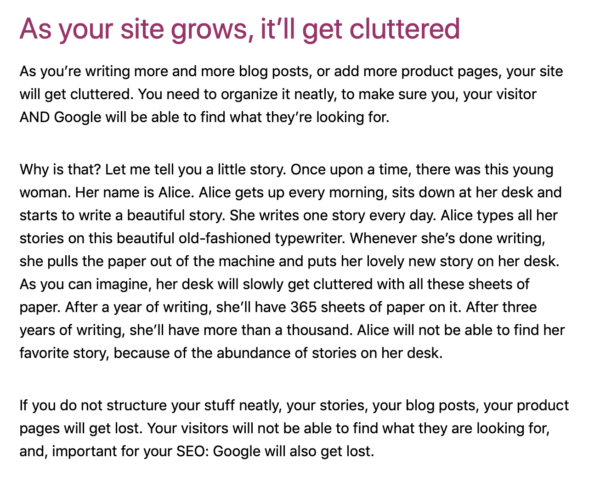Once upon a time, there was a young **** named Wende. She was incredibly intelligent, yet she had a hard time learning things by heart. No matter how hard she tried, she couldn’t memorize the planets of the solar system. One day, she asked her teacher what she should do. In response, he told her a story about the planets. A story about how the sun was lonely, and Mercury was his first friend. How Mercury fell madly in **** with Venus, which made Planet Earth jealous. After telling her the story, Wende was able to remember all of the planets in the right order. Why? Because of the magic of storytelling. Wende could remember the story and with that, she could remember the planets.
In this blog post, I’ll tell you what storytelling is and why it’s an important tool to use in the texts on your website.
What is storytelling?
The word storytelling speaks pretty much for itself, right? You tell stories. But storytelling is also about using stories to engage your audience or make something clearer, since stories are much easier to remember than simple facts. That’s why Wende from the story remembered the planets. In addition, stories are enjoyable; they stimulate your imagination. That’s why parents tell their children stories, and why we like to see movies and read books. People **** stories!
You can also use photos, pictures and film to help you tell a good story. You can even create your very own digital story with the use of storytelling.
Do you want to learn all about storytelling and SEO copywriting? In our SEO copywriting training, which is part of our Yoast SEO Academy training subscription, we’ll teach you how to write copy that ranks!
The 4 elements of storytelling
Now you know what storytelling is. But there’s more to it than simply telling a story, otherwise anyone could write a best-selling novel. To tell a good story, you usually have to include 4 elements: a character, a problem, an action, and a solution. Let’s dive a little deeper into these.
Every story needs a main character with a problem. Why? Because if someone is happy, there’s not really a story. Take Wende, for example. She wasn’t happy because she couldn’t memorize the planets of the solar system. That was the problem of the story. Next, you need action. Because a main character who doesn’t do anything to fix their problem isn’t fun to read about. In my example, Wende asked her teacher to help her. The teacher then told her a story, which made it easier for her to remember the planets. So, the story was the solution.
Why use storytelling?
Using storytelling in your blog post will – if you do it right – make your post more engaging. Your post will become something people want to read. In other words: Stories increase the attention of your audience. But they will also help you to clearly communicate your message. My story about Alice (see screenshot below) is written in order to help people understand the importance of a clean site structure, which can be a difficult subject to grasp.
Most importantly, however, is that people remember stories. Which means that if you use storytelling, people will also remember the message of your post or even your brand. You could even inspire people to take action, like cleaning up their website or getting started with storytelling in their blog posts and presentations.

When can you use storytelling?
Storytelling is a great and versatile tool. You can use it for posts, product pages and even presentations! I first got the idea to use storytelling for presentations in 2017, when I visited a conference and saw David JP Phillips on stage. He talked about the magical science of storytelling. I was blown away. His talk was such an inspiration for me. Two weeks later, I used this inspiration for my own talk at a WordCamp.
In addition to presentations, you can obviously use storytelling in writing. But it’s not limited to a certain type of blog. Lots of travel blogs or personal blogs use storytelling throughout all of their posts. Geraldine DeRuiter has a really funny blog about travel and many other things. Every post is a little story. Even informational blogs could use this principle by adding an anecdote or an example. In my post about site structure and why it is important, I use the exact same story as in my presentation at the WordCamp.
In this series
For this series, I’ve focused on using storytelling in your writing. For instance, I’ve written about how to use storytelling in a blog post, which discusses the elements that are necessary for a good story. The post also reveals some practical tips and examples of how to integrate storytelling into your blog posts! We also dove into the connection between storytelling and SEO, and discussed how you can use storytelling on product pages.
If you have nice examples of your own use of storytelling, or suggestions for related topics you’d like to read more about, I would **** to see those!
Read more: The complete guide to SEO copywriting »
Source link : Yoast.com

